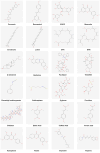From laboratory to clinic: opportunities and challenges of functional food active ingredients in cancer therapy
- PMID: 40808836
- PMCID: PMC12343285
- DOI: 10.3389/fnut.2025.1627949
From laboratory to clinic: opportunities and challenges of functional food active ingredients in cancer therapy
Abstract
This review provides a comprehensive analysis of the potential of functional food active ingredients in cancer prevention and therapy. It outlines the multifaceted anticancer mechanisms of bioactive compounds-such as polyphenols, carotenoids, omega-3 fatty acids, phytosterols, alkaloids, isothiocyanates, polysaccharides, phenolic acids, flavonols, and amide-bearing compounds-which include antioxidant and anti-inflammatory activities, induction of apoptosis and autophagy, modulation of the tumor microenvironment, interference with cell cycle regulation and signaling pathways, and regulation of cancer-related microRNA expression. The review further discusses the synergistic effects of these compounds when combined with conventional treatments like radiotherapy and chemotherapy, highlighting their role in enhancing efficacy and mitigating side effects. Despite promising preclinical data, challenges such as poor bioavailability, dose-dependent safety concerns, and the need for large-scale randomized clinical trials and regulatory standardization remain. Proposed future directions include advanced nanodelivery systems, eutectic technologies, and precision nutrition strategies, which together could accelerate the translation of these natural compounds from the laboratory to clinical application. Ultimately, the integration of functional food active ingredients into comprehensive cancer care may offer novel, safer, and more personalized approaches to oncologic treatment and prevention.
Keywords: bioactive compounds; cancer therapy; functional food; nanodelivery systems; precision nutrition.
Copyright © 2025 Zhang, Ren and Xu.
Conflict of interest statement
The authors declare that the research was conducted in the absence of any commercial or financial relationships that could be construed as a potential conflict of interest.
Figures





Similar articles
-
Prescription of Controlled Substances: Benefits and Risks.2025 Jul 6. In: StatPearls [Internet]. Treasure Island (FL): StatPearls Publishing; 2025 Jan–. 2025 Jul 6. In: StatPearls [Internet]. Treasure Island (FL): StatPearls Publishing; 2025 Jan–. PMID: 30726003 Free Books & Documents.
-
Innovations in cancer treatment: evaluating drug resistance with lab-on-a-chip technologies.Int J Pharm. 2025 Sep 15;682:125936. doi: 10.1016/j.ijpharm.2025.125936. Epub 2025 Jul 5. Int J Pharm. 2025. PMID: 40623610 Review.
-
Selected honey as a multifaceted antimicrobial agent: review of compounds, mechanisms, and research challenges.Future Microbiol. 2025 May-Jun;20(7-9):589-610. doi: 10.1080/17460913.2025.2498233. Epub 2025 Apr 28. Future Microbiol. 2025. PMID: 40293032 Review.
-
Systemic treatments for metastatic cutaneous melanoma.Cochrane Database Syst Rev. 2018 Feb 6;2(2):CD011123. doi: 10.1002/14651858.CD011123.pub2. Cochrane Database Syst Rev. 2018. PMID: 29405038 Free PMC article.
-
Systemic pharmacological treatments for chronic plaque psoriasis: a network meta-analysis.Cochrane Database Syst Rev. 2020 Jan 9;1(1):CD011535. doi: 10.1002/14651858.CD011535.pub3. Cochrane Database Syst Rev. 2020. Update in: Cochrane Database Syst Rev. 2021 Apr 19;4:CD011535. doi: 10.1002/14651858.CD011535.pub4. PMID: 31917873 Free PMC article. Updated.
References
Publication types
LinkOut - more resources
Full Text Sources

